Headless commerce is changing the dynamics of the e-commerce industry, helping brands get more creative freedom and provide tailored experiences to their customers.
The e-commerce industry has experienced a lot of changes lately. We have seen the growth of mobile commerce and social commerce, giving people quick access to products and services.
So, businesses need to be more flexible and agile in their operations to cope up with evolving technologies, customer demands, and competition.
This is where headless commerce can be helpful in enhancing site performance, scalability, and customer experience. No wonder its growth is projected to be US$3.9 billion by 2025.
In this article, I’ll discuss headless commerce, how it can help e-commerce businesses and some of the best headless commerce platforms that can be considered for your e-commerce store.
Let’s start!
What Is Headless Commerce?
Headless commerce is an architecture that an e-commerce store can have where its frontend is separated from its backend. This means that there’s no fixed frontend for an application.


As a result, the organizations following this architecture get more flexibility and speed while customizing their online stores. This is beneficial for the organization, its developers, and customers.
Headless commerce basically separates the application’s frontend layer, which may include things like styles, text colors, graphs, tables, buttons, images, etc., from the backend functionality, which may include aspects like security, infrastructure, pricing, checkout, and more.
Here, head = frontend
Rest of the (app) body = backend
This means that an online store’s frontend is not attached to its backend as opposed to traditional commerce, where both are attached to form a monolithic architecture.
By decoupling the online store part (that consumers use to interact with the application), headless commerce enables the company to better manage its inventory, data storage, security, and more. This way, you can improve your online store’s overall performance, accessibility, look, customization, personalization, customer experience, and more.
Headless commerce gives full creative freedom to a brand’s developers so they can provide enhanced e-commerce experiences. It is referred to as “API-first” because both ends communicate with each other via the API layer.
Developers can have greater development control, leverage composable technology stacks, and do much more with this architecture, which is why many love it. The best thing is that you can update your frontend without even affecting the backend.
Headless Commerce Features
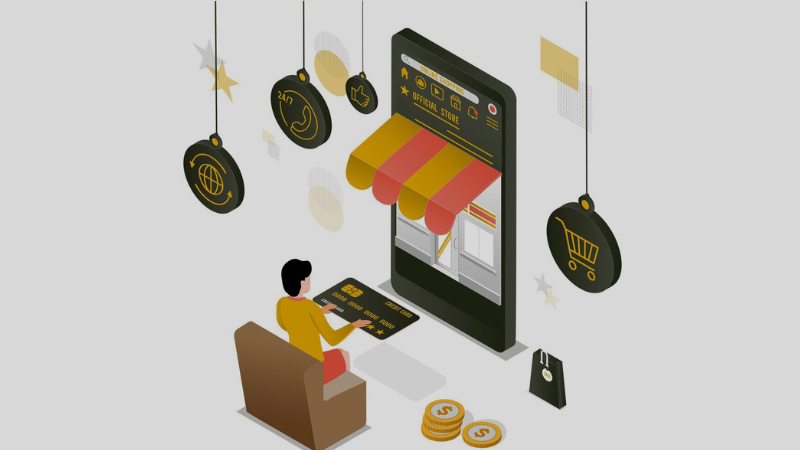

- Quick deployment: Headless commerce lets you deploy your application faster and make changes to it quickly like adding new features, improving existing features, enhancing the look, etc. with the frontend separated from the backend.
- Customization: You can customize your store easily without impacting your backend functionality. This way, you can offer tailored experiences to visitors and provide personalized services to them as well.
- Multi-channel: No matter where your customers are accessing your site from, you can stay consistent across mobile applications, websites, etc.
- Experimentation: With headless commerce, your developers can easily experiment with different looks, layouts, customizations, etc. They can also leverage the latest technologies to build applications and test them to improve performance, speed, experience, etc.
How Does Headless Commerce Work?
Headless commerce is a flexible approach that you can utilize to develop a seamless online store with a focus on customer experience.
Since your frontend and backend are not attached to this architecture, you need some means to make them interact with each other when you want to change something in your application. This is possible with an API call.
If you are familiar with APIs and how they work, you must know the benefits they offer – accessibility, adaptability, flexibility, etc. eliminating the need for creating dedicated apps for each purpose.
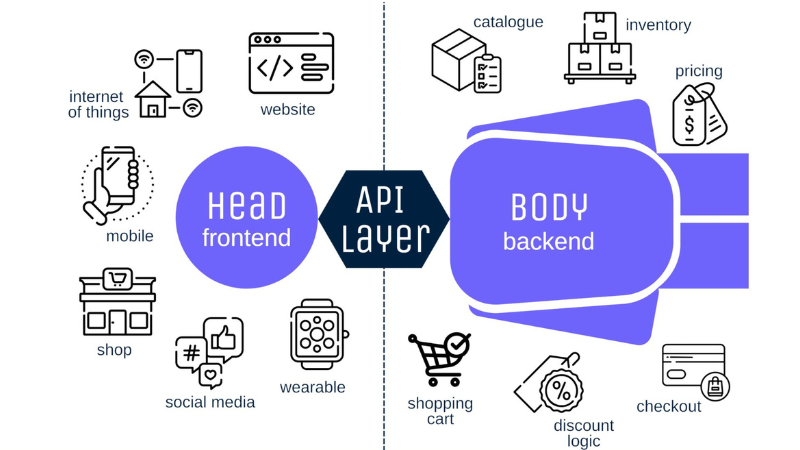

An API connects two applications or services. Similarly, in a headless architecture, an API is used to establish a connection between an online store’s frontend and backend. This way, you can make an API request whenever you want to change anything in the presentation layer of the online application or website.
From the presentation layer, the API will send a request to the application layer to take a certain action. Now, the application layer receives this request and processes it. Once it completes the request, it then sends this information to the presentation layer. Next, the change will be reflected in the store’s presentation layer.
Finally, the store’s visitors or customers will be able to see the change. It could be a pop-up order page, thank you message, payment status, design modifications, and so on.
Benefits of Headless Commerce


Improved User Experience
Improving user experience is one of the main priorities for any business. If you don’t work on that, you may risk losing your customers. With advancing technologies, businesses are finding ways to offer better solutions and experiences.
So, instead of sticking to traditional ways, you can adopt headless commerce to empower your developers. They can make quick updates, add new features, and improve other areas to deliver enhanced user experience.
Rapid Experimentation
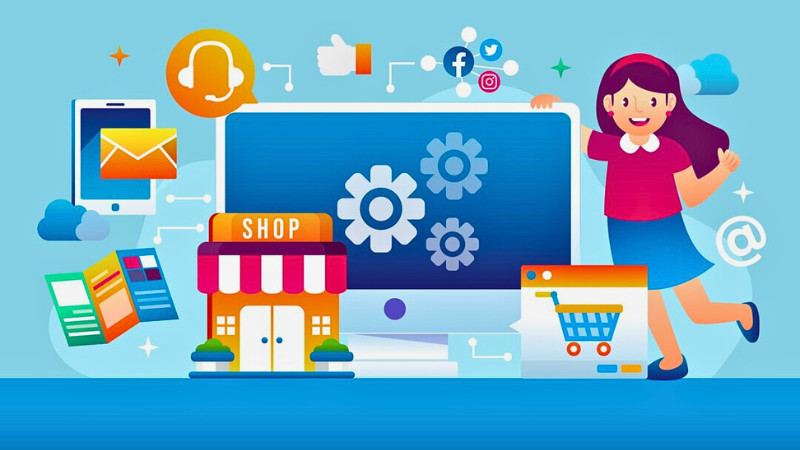

To stay competitive and continue offering the best services, you must keep on experimenting with different tools, technologies, designs, elements, etc. But if you follow the traditional ways, it becomes difficult to bring your experiments to reality.
Headless commerce promises to change that. It allows you to experiment and make changes rapidly without having to change anything in the backend. Thus, you can deliver the latest products and services to meet modern demands and never become obsolete.
Better Performance
No one likes a slow online store that takes forever to load its content or process user requests. If that happens with your site, it’s time you optimize it for performance.
When you adopt the headless commerce architecture, it becomes easier for you to detect and change things that are slowing down your site, be it plugins, site content, software systems, tools, etc. as compared to traditional architecture.
This way, you can enhance its performance without any downtime. Your visitors won’t be disturbed in this process and the changes will be applicable right away without the visitor knowing about it.
Scalability
Every business aims to grow. And when its customers, revenue, and sales start growing, it must have the capabilities to support its growth.
With the backend separated from the frontend, you can optimize both sides to scale your business. For instance, you can tweak your backend using the latest technologies, tools, and hardware so it can facilitate heavier transactions. At the same time, you can customize your frontend functionality to enhance its responsiveness.
Ease of Customization and Personalization
With headless commerce, you get to do what you want in your store without having to compromise with limited options, elements, layouts, etc. Whether it’s your product service page or blog, you can customize your entire site and make it more user-friendly and attractive.
Similarly, modern customers expect you to make them feel special. You can do this by offering personalized experiences that are tailored for them only. Headless commerce eases this process so you can make changes without changing anything in the backend.
Smooth Integrations
Headless commerce lets you integrate multiple tools, services, plugins, etc., with your online store easily. It can include CMS platforms, shopping carts, security tools, payment partners, etc. This helps enhance user experience while empowering your team to stay productive and accelerate workflow.
Adapting to Change
Market dynamics, customer preferences, and technologies keep on changing with time. In this scenario, you must not only be willing to adapt to these changes but also have the capabilities to be able to do that.
Many think that headless commerce is the future as its architecture is future-proof, enabling your business to meet modern demands. It caters to businesses of all sizes, whether you are a startup, SMB, or enterprise.
Headless Commerce vs. Traditional Commerce
| Parameters | Headless Commerce | Traditional Commerce |
|---|---|---|
| Structure | The main difference is that headless commerce involves a separate frontend and backend of an application. | Frontend and backend are attached in traditional commerce, which forms a monolithic structure. |
| Flexibility | By separating frontend from backend, headless commerce offers a higher flexibility of creativity, development, design, and modifications than traditional commerce. | Traditional commerce offers a rigid, monolithic structure where both frontend and backend are attached. So, if you change something in the frontend, it will require you to modify the backend, making the process more complex and time-consuming. |
| Customization | When you want to customize your store, you can do it quite easily without affecting the backend. | You get to do limited customizations with traditional commerce as a result of a rigid structure. |
| Speed | Making changes to an application is way faster and more convenient in headless commerce, which accelerates not only development but also deployment. | With the frontend attached to the backend, you first need to modify the backend so the required changes reflect in the frontend. This takes more time and effort. |
| Scalability | Headless commerce can easily adapt to changes if you want to scale up or down. This will support your growth without having to change everything in the backend. | Scaling your site up or down is more difficult with traditional commerce with limited extensibility. |
| Platform Optimization | Since your customers can access your product from different platforms like web browsers, mobile, desktops, etc., you can optimize user experience across different platforms. | Optimizing user experience on different platforms becomes challenging and time taking with traditional commerce. |
| Cost | Headless commerce typically requires higher investments for frontend than traditional commerce. | The cost of developing and maintaining the frontend is lower. |
Best Headless Commerce Platforms
Let’s now talk about some of the best headless commerce platforms and their offerings so you can decide which one is better for your e-commerce store.
#1. Adobe Commerce
Get a scalable and flexible e-commerce platform with Adobe Commerce and easily personalize B2C and B2B experiences.
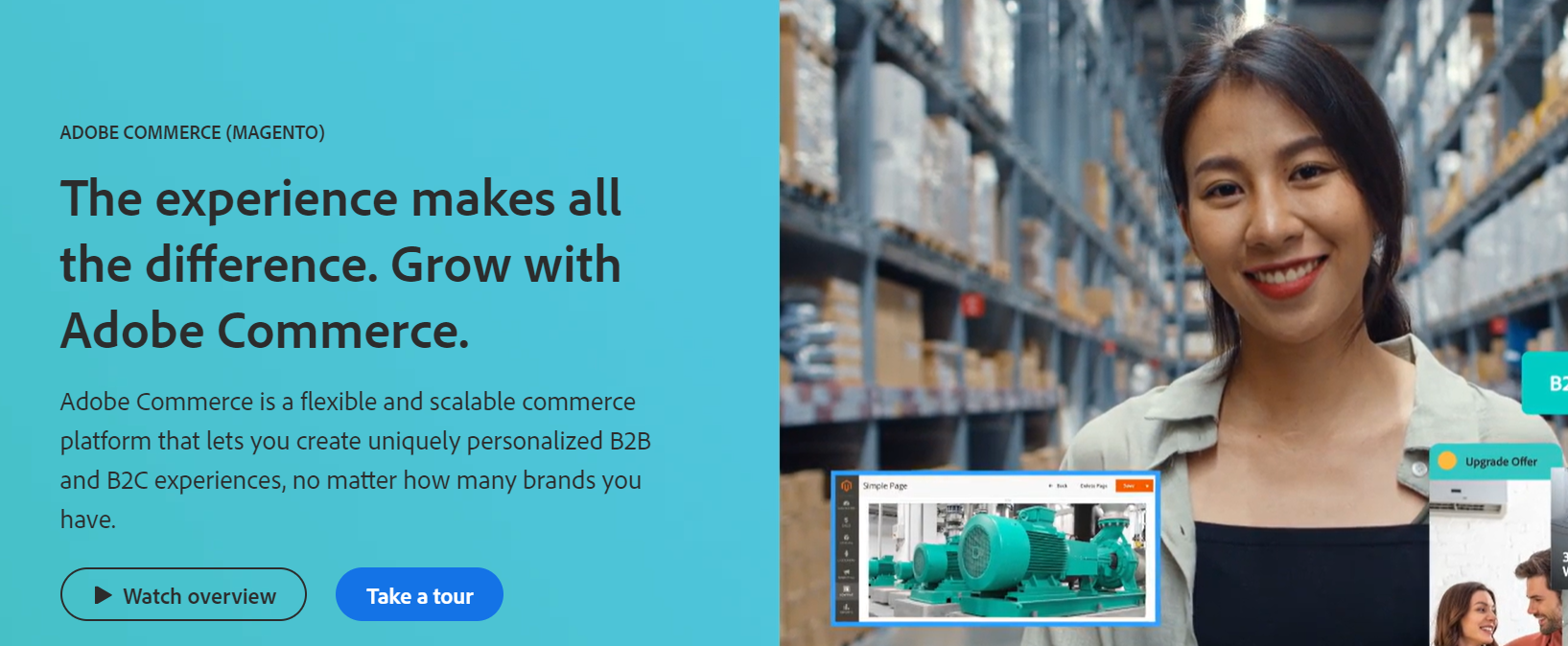

Even if you have multiple brands to manage, the platform will support your growth while offering the higher flexibility you need to implement new features and updates. You will get powerful tools to boost conversions by creating AI-driven experiences for B2C and B2B customers.
A great thing about Adobe Commerce is that it allows you to deliver promotions and content that the customers prefer. Also, you can enhance productivity and use AI to experience product recommendations, browsing, and site search.
Furthermore, you can extend your business reach to different customer segments and new countries. This helps you deploy plenty of storefronts rapidly. In addition, you can view B2B and B2C marketplaces or sites from a single interface.
Adobe Commerce lets you use API-first and developer tools to innovate. I noticed that the platform allows the building of custom applications and integrating third-party solutions easily, which any developer would love, isn’t it? As a result, you will be empowered to deliver fast experiences and reach your goals.
So, just fill out the form to get the quote for your B2B and B2C business.
#2. Shopify
Make your commerce platform better for every segment of customers across the world with Shopify. It supports the next-gen technology for entrepreneurs.
I’m amazed at the fact that the platform offers a composable and modern stack for enterprises, commerce solutions for newly emerging brands, and a powerful API to build your commerce future.


With Shopify’s drag-and-drop store creator, you can build your online storefront quickly without using any code skills. You will get customizable templates for crafting your brand. In addition, you can add functionalities and features to the e-commerce store with various applications by Shopify.
With multiple marketing tools, sales channels, and social integrations, Shopify enables brands to reach their targeted customers and sell in person, online, and worldwide. Another interesting thing about Shopify is Shop Pay – an online checkout tool that Shopify offers to facilitate fast and reliable checkouts.
#3. Swell
Experience API-first and customizable e-commerce platform – Swell for your next-gen commerce store. With JavaScript SDK enabled, you can effortlessly create advanced commerce apps and meet unique business needs.
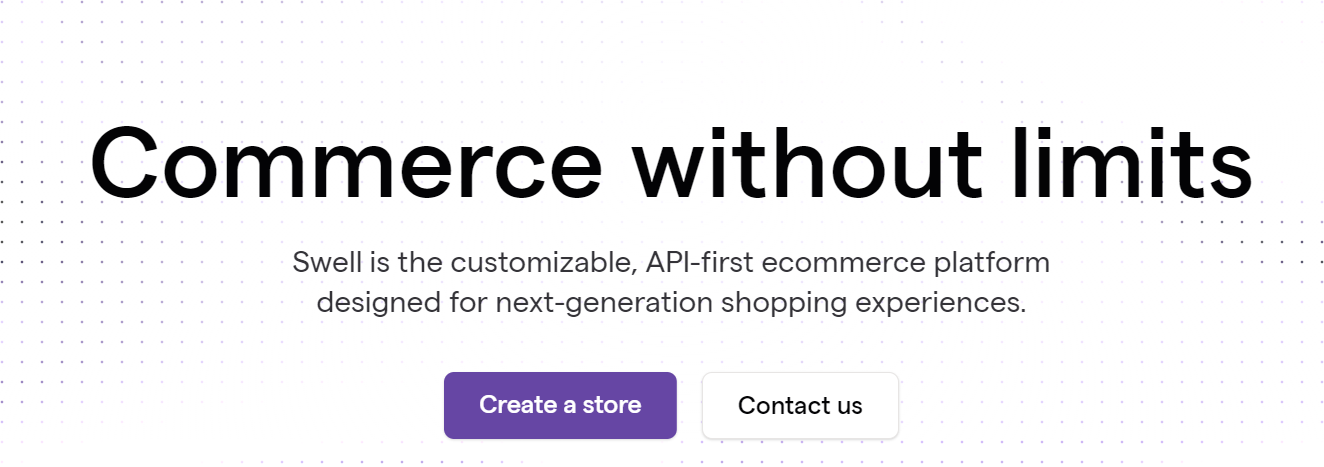

If you want to create a new platform and store content and business data together, add various fields to your standards model. Swell enables you to sell personalized and configurable products, subscriptions, and bundles without any limits on variants or options.
I tried flexible and rich options for product variations with Boolean toggles, open-ended texts, and selectable values and found them performing pretty amazingly. The platform also defines several filterable specifications and characteristics across the product catalog.
Tracking each item by its SKU code is easier with Swell. You can make a combination of multiple products into configurable bundles, choose from product options, and generate different combinations of variants to manage pricing, availability, inventory, images, and text.
#4. Spryker
Spryker offers a composable e-commerce platform to cope with business challenges in B2B, B2C, enterprise marketplace, or IoT commerce by facilitating innovation and advanced capabilities.
If you wish to transform your e-commerce store into an enterprise-level marketplace, it’s possible with Spryker. You can quickly build a scalable marketplace from scratch and leverage its IoT integrations to expand the list of connected devices.
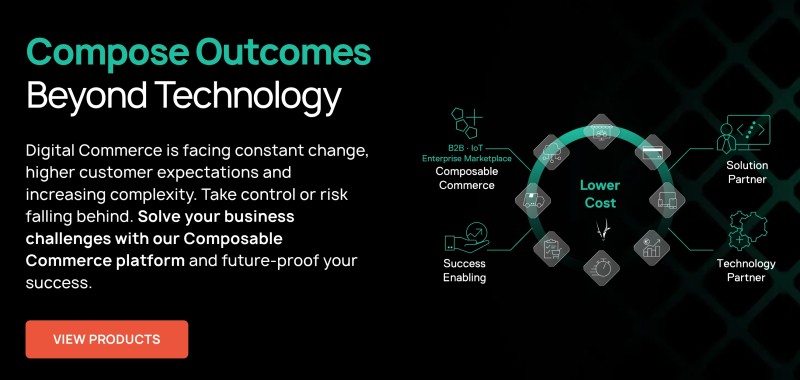

I found that the platform offers lean systems, short testing cycles, and efficient development, which means you will enter the market quickly. Spryker reduces the total cost of implementing technology with its composable product implementation.
Along with reducing complexity, it will help enhance your ROI, overall platform value, and collaboration. As a result of Spryker’s valuable and future-proof capabilities, you can take your digital commerce to the next level.
Conclusion
Headless commerce architecture gives you the flexibility you need to build a unique e-commerce store with enhanced speed, performance, and customization.
As a result, your user interface and the overall store’s functionality improve quickly without disturbing your backend. This attracts more visitors and boosts conversions and customer experience.
So, it’s time to say goodbye to traditional commerce and adapt to headless commerce to meet modern demands. You can use one of the above headless commerce platforms that best suits your business.
You may also read about the complete guide to eCommerce.
Si quiere puede hacernos una donación por el trabajo que hacemos, lo apreciaremos mucho.
Direcciones de Billetera:
- BTC: 14xsuQRtT3Abek4zgDWZxJXs9VRdwxyPUS
- USDT: TQmV9FyrcpeaZMro3M1yeEHnNjv7xKZDNe
- BNB: 0x2fdb9034507b6d505d351a6f59d877040d0edb0f
- DOGE: D5SZesmFQGYVkE5trYYLF8hNPBgXgYcmrx
También puede seguirnos en nuestras Redes sociales para mantenerse al tanto de los últimos post de la web:
- Telegram
Disclaimer: En Cryptoshitcompra.com no nos hacemos responsables de ninguna inversión de ningún visitante, nosotros simplemente damos información sobre Tokens, juegos NFT y criptomonedas, no recomendamos inversiones



